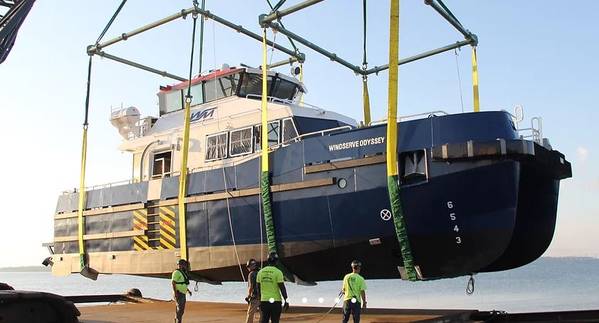
WindServe Marine's offshore wind crew transfer vessel Windserve Odyssey, built by its sister company Senesco Marine, is embarking upon sea trials on the U.S. East Coast.
The news of the vessel launch was shared Thursday by the world's largest offshore wind developer Orsted, via social media.
The Windserve Odyssey will support Orsted's U.S. offshore wind projects along the U.S. the East Coast.
"After sea trials at Ørsted’s Block Island Wind Farm, the Odyssey will travel from Rhode Island to Virginia to join the closeout of construction and commissioning of the Coastal Virginia Offshore Wind project," Orsted said.
"We’re happy to celebrate this achievement, which indicates the United States’ readiness for offshore wind and Rhode Island’s impressive capability for this type of shipbuilding," Orsted said.
Senesco has traditionally built tugs and barges for the energy transportation industry but has recently delved into aluminum boat construction business.
In a recent interview given to MarineLink Mike Foster, Vice President and General Manager at Senesco Marine, said: "What I see is complete difference in the types of things we build, from tugs and barges to offshore wind support vessels and structures. The market has changed, and we have a great opportunity to go after this new market.”
CTV Duo
Ørsted and WindServe last year entered into a deal to construct two purpose-built offshore Crew Transfer Vessels (CTVs), which will transport personnel for construction, maintenance, and operation from port to offshore wind farms. One of them is the Windserve Odyssey, built by Senesco, while the other is built by U.S. Workboats in Hubert, North Carolina.
The WindServe Odyssey will join the closeout of construction and commissioning of the Coastal Virginia Offshore Wind project, however, the vessel has been built specifically for Ørsted’s and Eversource’s Revolution Wind project located off the southern New England coast, expected to be commissioned in 2023.
According to the American Wind Energy Association, the U.S. shores possess a power potential of more than 2,000 gigawatts (GW), nearly double the nation's current electricity use.
In a report earlier this year, AWEA said that developing 30,000 megawatts (MW) of offshore wind along the East Coast could support up to 83,000 jobs and deliver $25 billion in annual economic output by 2030.
Watch the recording of World Energy Report's Offshore Wind Webinar "Outlook for Offshore Wind Power: The Frontier of Future Energy"



